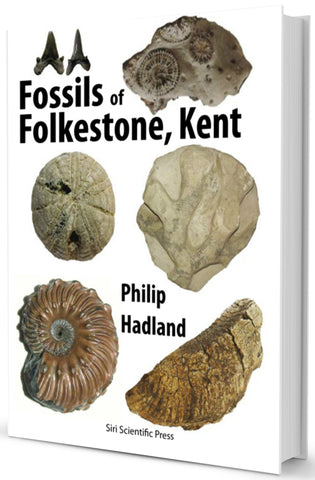New Release for 2018: Fossils of Folkestone, Kent
Posted by David Penney on
We are very pleased to announce our first release of 2018, formally published as of today: Fossils of Folkestone, Kent by Philip Hadland. Click cover below to go to the product page for more info (or see below) and order your copy.
Folkestone is arguably one of the best fossil-hunting grounds in the UK and is especially famed for its great diversity of exceptionally well preserved ammonites. In this family friendly photographic field guide the author covers the major different fossil groups likely to be found in the Lower Greensand, Gault Clay, Chalk and Pleistocene settings. More than 200 fossil species are illustrated in a series of 100 full-page, colour plates.
The author has been collecting fossils at Folkestone for around a decade and has been involved with curating various collections containing Folkestone specimens, including at Canterbury Museum, the Oxford University Museum of Natural History, and most recently he has been involved in establishing the new Folkestone Museum. The book includes a foreword by well-known palaeontologist Dean R. Lomax, author of Dinosaurs of the British Isles and Fossils of the Whitby Coast.
From the back cover
Folkestone is surely one of the top ten places to look for fossils in Britain. The variety of fossils that can be found there is truly staggering. For centuries geologists have visited Folkestone, mainly attracted by the beautiful Gault Clay ammonites that are so abundantly found along the beach. Aside from ammonites and other invertebrate fossils, a rich variety of vertebrates has been found, including rare dinosaur remains. There is no doubt an untapped potential for new and exciting discoveries at Folkestone.
This book aims to showcase the spectacular fossils that can be found at Folkestone in a series of 100 full colour plates (see below), illustrating approximately 200 different species from the Chalk, Gault Clay, Lower Greensand and also the Pleistocene mammal fauna. It is designed as a user-friendly identification guide for anyone collecting fossils there and hopefully will encourage more people to collect there and report any new rare finds.
Foreword by Dean R. Lomax
With the exception of the most dedicated of fossil hunters, or geological societies, the word ‘fossil’ would not necessarily be the first thing that springs to mind when thinking about Folkestone. Yet, Folkestone can claim fame to a rich history of fossil collecting that has been ongoing for centuries. It has yielded some incredible specimens, including several species new to science, and one-of-a-kind fossils.
Folkestone is a town situated on the English Channel, in south-east England. However, travel back in time and things were very different. A tropical sea covered most of what is now Folkestone. It was populated by many unusual and fascinating animals, including giant marine reptiles and wonderfully unusual ammonites. Even dinosaurs walked along the coastal regions, leaving their footprints preserved in deep time. These animals lived during the middle part of the Cretaceous Period, around 112 to 100 million years ago, and their fossils are found in three primary geological units exposed at Folkestone: Lower Greensand, Gault Clay, and Chalk.
Every fossil has its own story, but in order for that story to come to life it has to be found. One of the most prolific fossil collectors at Folkestone was John Griffiths. The likes of Griffiths laid the foundations for interest in fossils at Folkestone. One of his most notable discoveries includes the armoured ankylosaur Acanthopholis horrida, which was found near Folkestone and is one of only very few Late Cretaceous dinosaurs in the UK. Thousands of other fossils have been found by fossil hunters of all ages and many are illustrated throughout this book. Ammonites, for example, are among the most common fossils at Folkestone. Hundreds of species of various shapes and sizes have been found, and they are often exceptionally preserved with their original shell, especially in the Gault Clay.
The fossils of Folkestone have helped fill gaps in prehistoric life during the Cretaceous. They are genuinely among some of the most interesting and beautifully preserved fossils in the UK. With such a great variety of fossils found at Folkestone, it should be on every fossil hunters bucket list to visit. Fossils are incredibly common and you will never leave disappointed. To further your interests in Folkestone fossils, I would thoroughly recommend visiting Folkestone Museum to explore more about the fossils that have been found at this locality.
I commend Philip for putting so much time, effort and patience in creating what is an important contribution to the palaeontological literature of the UK. This book will be of great use to fossil enthusiasts of all ages, from amateurs to professionals. Enjoy!
Dean R. Lomax
Palaeontologist & Visiting Scientist,
The University of Manchester, UK
Patron, UK Association of Fossil Hunters (UKAFH)
www.deanrlomax.co.uk
List of plates
LOWER GREENSAND PLATE 1: Trace Fossils
LOWER GREENSAND PLATE 2: Trace Fossils
LOWER GREENSAND PLATE 3: Brachiopods
LOWER GREENSAND PLATE 4: Bivalves
LOWER GREENSAND PLATE 5: Gastropods
LOWER GREENSAND PLATE 6: Ammonites
LOWER GREENSAND PLATE 7: Ammonites
LOWER GREENSAND PLATE 8: Ammonites
LOWER GREENSAND PLATE 9: Barnacles
LOWER GREENSAND PLATE 10: Lobsters
LOWER GREENSAND PLATE 11: Echinoderms
LOWER GREENSAND PLATE 12: Fish
LOWER GREENSAND PLATE 13: Dinosaurs
GAULT PLATE 1: Trace Fossils
GAULT PLATE 2: Trace Fossils
GAULT PLATE 3: Corals
GAULT PLATE 4: Bryozoans
GAULT PLATE 5: Serpulids
GAULT PLATE 6: Brachiopods
GAULT PLATE 7: Bivalves
GAULT PLATE 8: Bivalves
GAULT PLATE 9: Gastropods
GAULT PLATE 10: Gastropods
GAULT PLATE 11: Gastropods
GAULT PLATE 12: Gastropods
GAULT PLATE 13: Scaphopods
GAULT PLATE 14: Nautiloids
GAULT PLATE 15: Belemnites
GAULT PLATE 16: Ammonites
GAULT PLATE 17: Ammonites
GAULT PLATE 18: Ammonites
GAULT PLATE 19: Ammonites
GAULT PLATE 20: Ammonites
GAULT PLATE 21: Ammonites
GAULT PLATE 22: Ammonites
GAULT PLATE 23: Ammonites
GAULT PLATE 24: Ammonites
GAULT PLATE 25: Ammonites
GAULT PLATE 26: Ammonites
GAULT PLATE 27: Ammonites
GAULT PLATE 28: Ammonites
GAULT PLATE 29: Ammonites
GAULT PLATE 30: Ammonites
GAULT PLATE 31: Ammonites
GAULT PLATE 32: Ammonites
GAULT PLATE 33: Ammonites
GAULT PLATE 34: Ammonites
GAULT PLATE 35: Ammonites
GAULT PLATE 36: Ammonites
GAULT PLATE 37: Ammonites
GAULT PLATE 38: Ammonites
GAULT PLATE 39: Ammonites
GAULT PLATE 40: Ammonites
GAULT PLATE 41: Ammonites
GAULT PLATE 42: Ammonites
GAULT PLATE 43: Ammonites
GAULT PLATE 44: Ammonites
GAULT PLATE 45: Crustaceans
GAULT PLATE 46: Lobsters
GAULT PLATE 47: Crabs
GAULT PLATE 48: Crabs
GAULT PLATE 49: Echinoderms
GAULT PLATE 50: Vertebrates – Sharks
GAULT PLATE 51: Vertebrates – Chimaeroids
GAULT PLATE 52: Vertebrates – Bony Fish
GAULT PLATE 53: Vertebrates – Bony Fish
GAULT PLATE 54: Vertebrates – Bony Fish
GAULT PLATE 55: Vertebrates – Bony Fish
GAULT PLATE 56: Vertebrates – Bony Fish
GAULT PLATE 57: Vertebrates – Reptiles
GAULT PLATE 58: Vertebrates – Reptiles
GAULT PLATE 59: Vertebrates – Reptiles
CHALK PLATE 1: Sponges
CHALK PLATE 2: Coral & Serpulid
CHALK PLATE 3: Brachiopods
CHALK PLATE 4: Bivalves
CHALK PLATE 5: Bivalves
CHALK PLATE 6: Bivalves
CHALK PLATE 7: Bivalves
CHALK PLATE 8: Gastropods
CHALK PLATE 9: Ammonites
CHALK PLATE 10: Ammonites
CHALK PLATE 11: Ammonites
CHALK PLATE 12: Ammonites
CHALK PLATE 13: Ammonites
CHALK PLATE 14: Crustaceans
CHALK PLATE 15: Echinoderms – Starfish
CHALK PLATE 16: Echinoderms – Sea Urchins
CHALK PLATE 17: Vertebrates – Fish
CHALK PLATE 18: Vertebrates – Fish
CHALK PLATE 19: Vertebrates – Fish
CHALK PLATE 20: Vertebrates – Fish
CHALK PLATE 21: Vertebrates – Reptiles
PLEISTOCENE MAMMALS PLATE 1 – Mammoth
PLEISTOCENE MAMMALS PLATE 2 – Woolly Rhino
PLEISTOCENE MAMMALS PLATE 3 – Woolly Rhino
PLEISTOCENE MAMMALS PLATE 4 – Red Deer
PLEISTOCENE MAMMALS PLATE 5 – Hippopotamus
PLEISTOCENE MAMMALS PLATE 6 – Hippopotamus
PLEISTOCENE MAMMALS PLATE 7 – Auroch
Share this post
- 0 comment
- Tags: New release, News
0 comment

